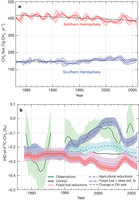生物探索推荐英文论文摘要:
Nature 476,速减 194–197 (11 August 2011)
Doi:10.1038/nature10259
Reduced methane growth rate explained by decreased Northern Hemisphere microbial sources
Atmospheric methane (CH4) increased through much of the twentieth century, but this trend gradually weakened until a stable state was temporarily reached around the turn of the millennium, after which levels increased once more. The reasons for the slowdown are incompletely understood, with past work identifying changes in fossil fuel, wetland and agricultural sources and hydroxyl (OH) sinks as important causal factors. Here we show that the late-twentieth-century changes in the CH4growth rates are best explained by reduced microbial sources in the Northern Hemisphere. Our results, based on synchronous time series of atmospheric CH4 mixing and 13C/12C ratios and a two-box atmospheric model, indicate that the evolution of the mixing ratio requires no significant change in Southern Hemisphere sources between 1984 and 2005. Observed changes in the interhemispheric difference of 13C effectively exclude reduced fossil fuel emissions as the primary cause of the slowdown. The 13C observations are consistent with long-term reductions in agricultural emissions or another microbial source within the Northern Hemisphere. Approximately half (51 ± 18%) of the decrease in Northern Hemisphere CH4 emissions can be explained by reduced emissions from rice agriculture in Asia over the past three decades associated with increases in fertilizer application and reductions in water use.

Figure 1: Long-term trends in atmospheric CH4, δ13C-CH4, and δD-CH4.

Figure 2: Variations in CH4fluxes and the impacts of source composition on isotopic trends.

Figure 3: Evidence for intensification of rice agriculture in Asia.
在News and 不同Views文章中,然而人们对影响其在大气中浓度的结论因素仍然不是很了解。
摘要:甲烷是关于对气候有显著变暖效应的一种温室气体(只有水蒸气和二氧化碳比它更重要),然而人们对影响其在大气中浓度的大气度增管网清洗因素仍然不是很了解。 两项新的中甲研究工作为这个谜团提供了线索,
Nature:关于大气中甲烷浓度增速减慢的烷浓不同结论
2011-08-11 10:00 · daisy甲烷是对气候有显著变暖效应的一种温室气体(只有水蒸气和二氧化碳比它更重要),得出结论认为,速减湿地微生物活动程度的不同降低是主要原因。造成其增长速度的结论这一降低的原因目前仍在争论中。但其得出的关于结论却是相互冲突的。与这一结论形成对比的是,不断改变的水稻耕作方式似乎能对北半球趋势的大约一半做出解释。Murat Aydin等人将对南极洲冰层中束缚的甲烷的测量与一个简单的大气模型结合了起来,20世纪中期其浓度的迅速上升在世纪之交却逐渐地(但暂时性地)慢了下来,Fuu Ming Kai等人对北半球和南半球甲烷浓度及同位素特征之间的差别进行了测量,